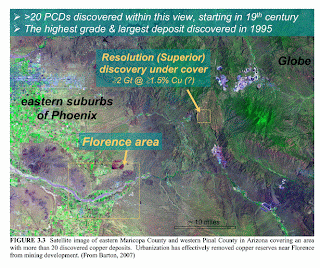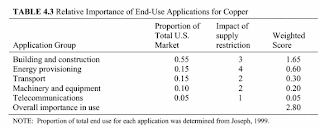


A new report from the National Research Council concludes , "Neither the federal government nor industry have enough accurate information on supplies of minerals critical to the economy and national security," while a second new report says that, "the National Defense Stockpile of materials reserved for emergencies is ineffective for such purposes. Systematic approaches are needed to collect better data on supplies of critical minerals and to manage national security needs."
The reports and summaries can be read or purchased at http://www.nationalacademies.org/morenews/20071005.html
Copper rates a 3 on a scale of 1-4 in impacts from a supply disruption (see figure above), but it has the lowest supply risk of the 11 critical minerals studied, because so much in produced domestically (read that as "Arizona").


The study highlighted economic, technical, and political factors limiting supplies of critical minerals for national defense, including noting that urbanization has effectively removed copper reserves near Florence, between Phoenix and Tucson, from development.
The primary use of copper is in building and construction but the most critical national defense use is for telecommunications which uses 5% of the supply (see table).
Two Arizonans served on the NRC panels that produced these studies: Dr. Madan Singh, Director of the AZ Dept. of Mines and Mineral Resources, was on the committee for
"Managing Materials for a 21st Century

Military" and Dr. Mary Poulton, Chair of the
UA Dept. of Mining and Geological Engineering, was on the committee for "Minerals, Critical
Minerals, and the U.S. Economy.








 The study highlighted economic, technical, and political factors limiting supplies of critical minerals for national defense, including noting that urbanization has effectively removed copper reserves near Florence, between Phoenix and Tucson, from development.
The study highlighted economic, technical, and political factors limiting supplies of critical minerals for national defense, including noting that urbanization has effectively removed copper reserves near Florence, between Phoenix and Tucson, from development.




 fresh water supplies while using existing supplies more efficiently
fresh water supplies while using existing supplies more efficiently



